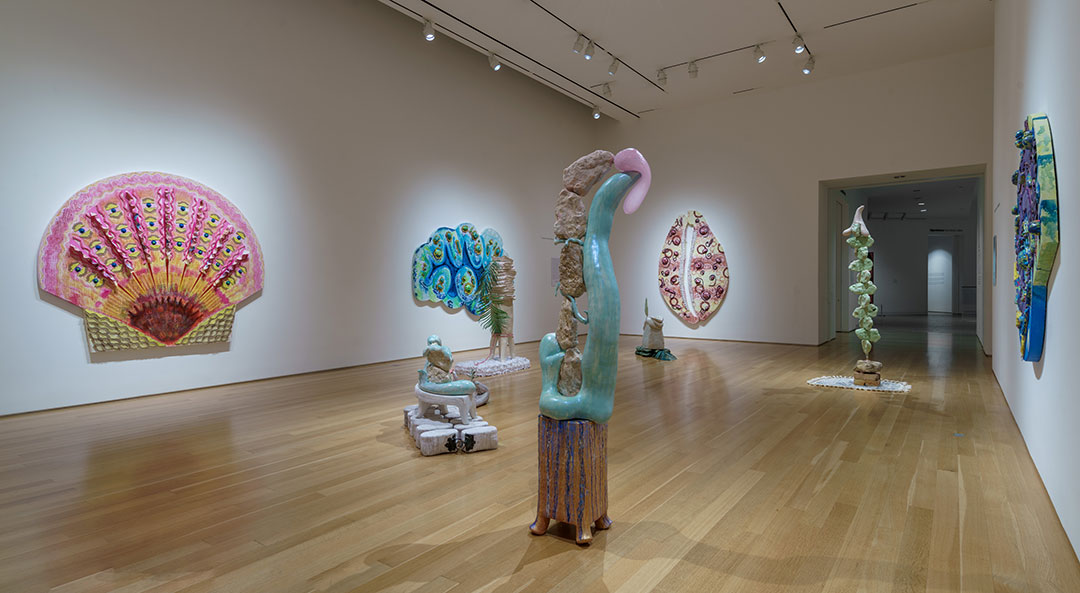Each year, Kansas City arts non-profit Charlotte Street enlists a panel of guest judges to select three local artists for their annual Visual Artist Award. The winners participate in an exhibition and are given $10,000, the largest unrestricted prize designated for a local KC artist. This year’s awardees, SunYoung Park, Sean Nash, and Ruben Castillo, have their exhibition: Charlotte Street Fellows ᐧ 2023.
The exhibit acts as three individual shows even though it is technically a group show. There is no theme, and in past years, the artists have had separate spaces. This year, Castillo has his own room, while Nash and Park are grouped together, a choice that was perhaps made due to a simple lack of space. Nash and Park use similar color palettes and work in scales roughly bigger than 4’ x 4’ x 4’. The amount of work overcrowds the space while chromatic similarities make the work less distinguishable. Both artists would have benefitted from having their work displayed in their own area.
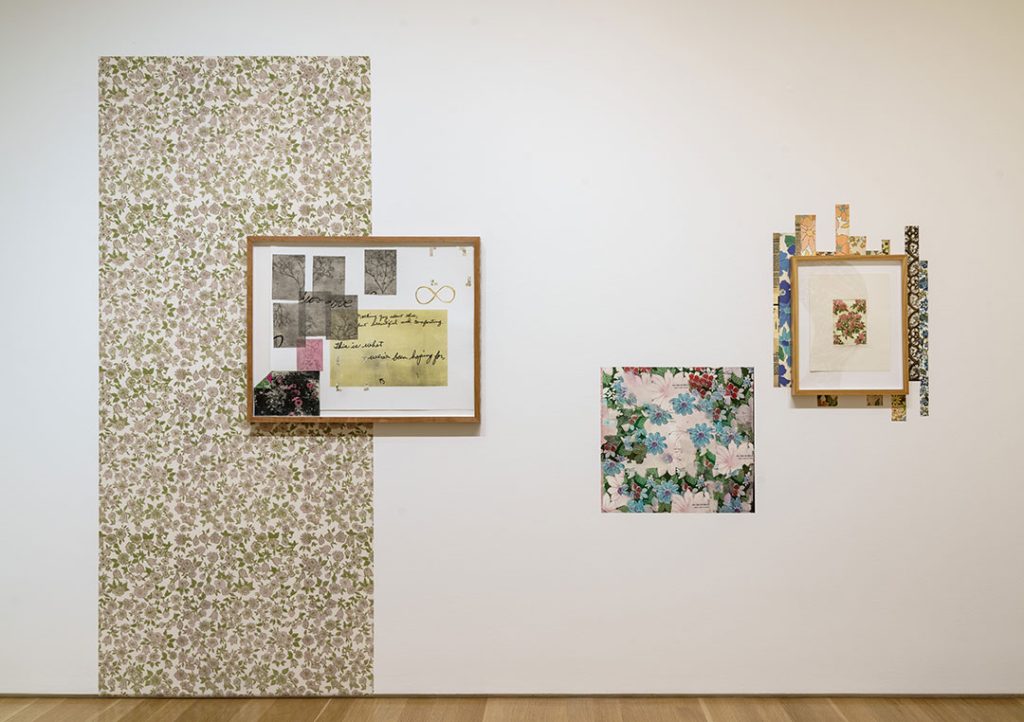
Ruben Castillo, an educator and multimedia artist specializing in printmaking, created an installation layering lithographs, etchings, vinyl, and woodblock prints to promote, extend, and process the archive of Kansas City gay rights activist Phyllis Shafer. In the late sixties and seventies, Shafer regularly wrote advice-like columns for The Phoenix, her son Drew Shafer’s publication. She also helped him run the Phoenix Society and House, a gay boarding house and community center. For her personal archive—now housed at GLAMA (Gay and Lesbian Archives of Mid-America)—she saved headlines and articles beginning in the 1930’s, most of which relate to gay socio-political issues, stopping around the time her son was diagnosed with HIV/AIDS in 1987. She pasted the clippings in repurposed books of wallpaper samples and added personal notes in the margins. As an homage or reenactment, Castillo also repurposes, sampling from scans of Shafer’s scrapbooks and intermixing them with his own prints. Aesthetically, the installation’s cleanliness is reminiscent of other artists working with archive and installation such as Wolfgang Tillmans or Kameelah Rasheed, as opposed to a more chaotic style like Thomas Hirschhorn. Castillo’s uniqueness among this genre lies in his focus on queer Kansas City history and his masterfully crafted prints. His etching, Wallpaper Proposal (Rhododendron), a framed 5″x7” pattern of pink rhododendrons is a subtle gesture, placed with nuance, that imparts grief, love, and the intimacy of touching hand to paper. Another favorite moment, Gay Talk (Invert, In the Flowers), assembles lithographs to appear like a pamphlet over wallpaper inside a wooden frame. The black and white cut-apart image of two men embracing on the pamphlet reminds me of Castillo’s previous work documenting intimacy and memory contained within objects shared by him and his partner. I am drawn to Castillo’s recent shift to archival research. In doing so, he proposes a rhizomatic approach by advocating for several interconnected yet distinguishable avenues for us to explore queer history and theory.
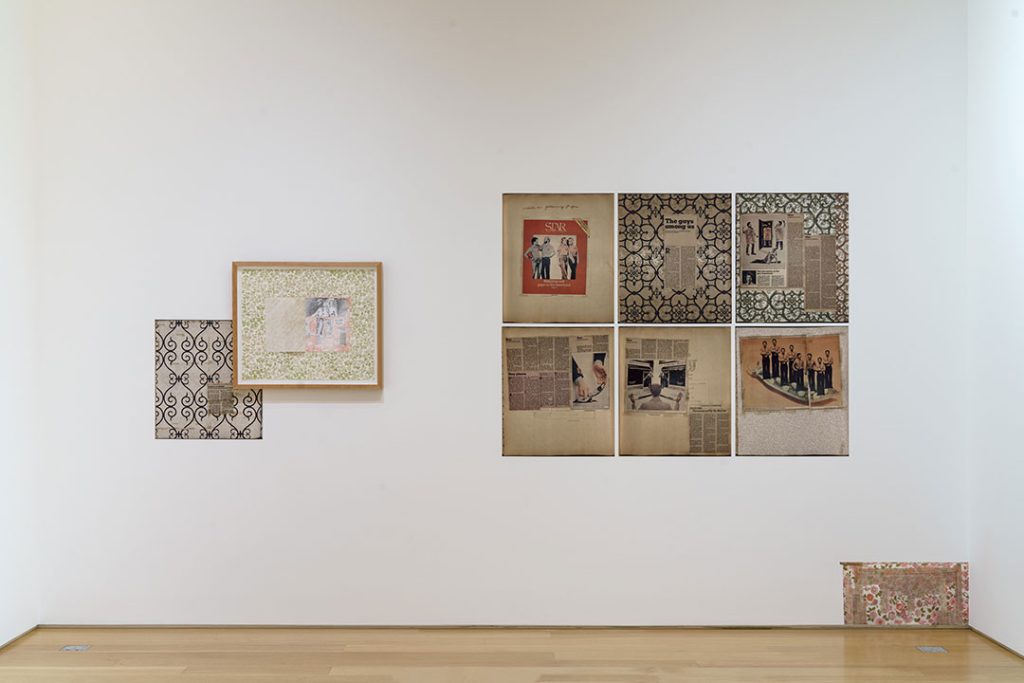
Sean Nash is a multidisciplinary artist based in Kansas City working broadly in the field of ecology. Specifically, Nash experiments with fermentation and food. His large-scale, three dimensional wall pieces diverge a bit from his previous work with the inclusion of sea life. Each piece represents a specific marine animal, with some clearly representing their inspiration, like the ammonite, while others, like the incomplete silhouette of the lionfish larva, are abstracted. They are decorated with casts of produce, body parts, and everyday food containers. The size and colors are playful like SpongeBob or the displays at aquariums. The kitsch aesthetic choices of pink frills and bright primary colors date to the late eighties and early nineties, when environmentalism was optimistic. It was the time of Captain Planet and recycling. However, Nash’s work avoids the now dated optimism of that time, instead portraying our present day, ambiguously depressing environmental realities. One way Nash delivers this reality is by grafting plastic containers onto the sea creatures, replicating the real-life impact of plastics in the ocean (see Eurythenes plasticus). He also quotes Rachel Carson’s 1962 book on the dangers of pesticides, Silent Spring, which is credited with inspiring the creation of the Environmental Protection Agency. While this could be a celebration of a historical enviro-political victory, it is also a reminder of ongoing political failures. Just three years ago, Monsanto, now part of Bayer, settled a string of lawsuits to the tune of $10 billion because their pesticide RoundUp causes cancer.
I appreciated the clever semiotic references throughout Nash’s works. My favorite was Scallop eyes watching Shell Global (calico scallop), in which Nash questions the oil giant’s scallop logo, an animal the company kills. This work, along with The asterisk in trans* and a salty recipe for transmutation (larval lionfish), stand out among the works due to their bold color palettes. Nash manages the color beautifully, attaching a green painted cast of an okra to a spotted, watery looking background of more muted blues, pinks, and greens. The more chromatically uniform works have a neutrality to them that diminishes the experience. I also think these works are in want of some programming or didactic information. I gleaned a lot more enjoyment from the work after Nash’s artist talk, but I guess that is true for most exhibiting artist talks. In this case though, Nash employs an educational aesthetic, so the absence of readily available information is more pronounced.
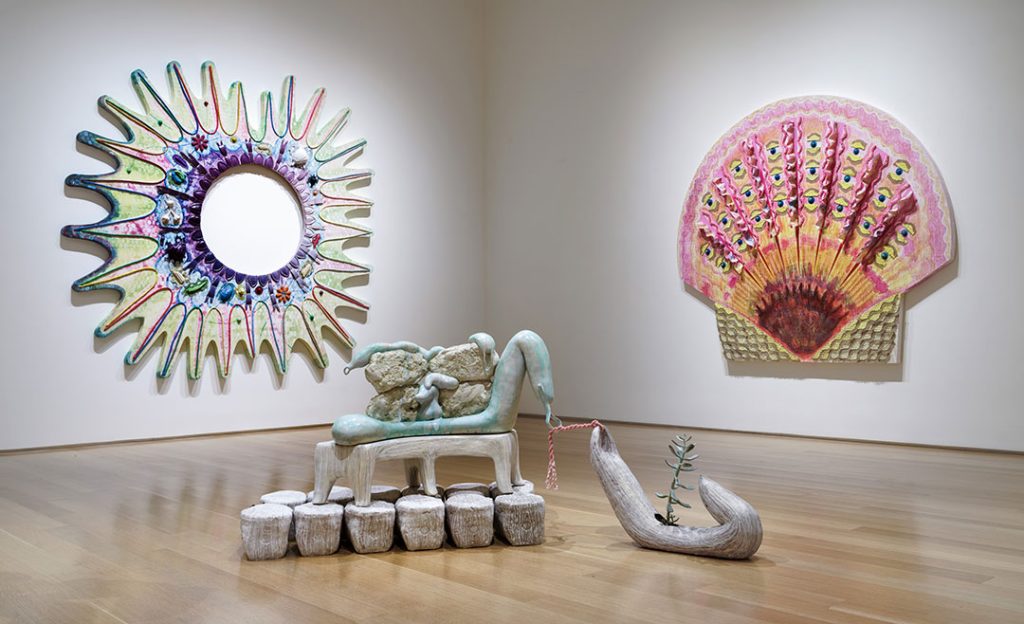
SunYoung Park combines dream, imagination, perceptive sensations, and Korean cultural references to assemble a dream-like vignette. Her five sculptures bring to mind stones and pillows, or resemble enlarged body parts like fingers and skin. Each sculpture is a full set. By this, I mean that instead of individual objects, the sculptures contain a kit of parts. They all rest on some type of furniture and a few have accessories such as tassels or pins. It makes sense that Park cites Gustave Moreau’s painting The Apparition as well as banana flowers as inspiration. Like the painting and the plant, she dynamically melds beauty with the intestinal. For example, there are many pretty green worm figures that also look like giant fingers. Like her inspirations, Park’s bodily references do not disgust but rather induce a sense of desire. Another connection Park has to Moreau is in the way she taps into the spiritual. Her stone stacks reference the stone pagodas around the Buddhist temple Tapsa at Maisan, while the ornateness with which she decorates her sculptures is akin to objects found inside of that temple.
I see Park as a surrealist. Like the original surrealists, she aims to depict the functioning of feeling and/or thought. She engages in a process to mimic her processing of reality, intentionally opting for methods of production like large-scale hand-built ceramics that mirror the time it takes to perceive. In other words, she has to take her time to make her work. Other contemporary ceramicists like Genesis Belanger and Rose Eken have been similarly categorized as surrealist for their reworking of everyday objects, but Park is more in tune with surrealism’s core concept to tap into the unconscious mind.
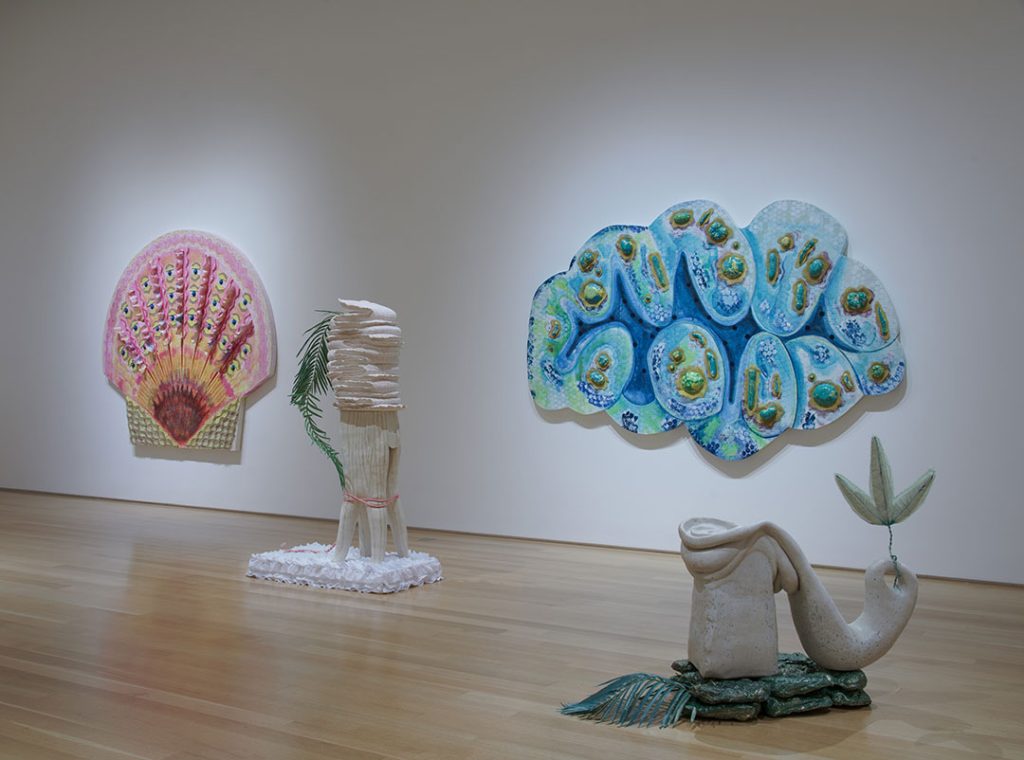
As stated previously, this $10,000 award is the largest cash prize specifically designated for local Kansas City artists. It is an important incentive for artists in KC. Cheap rent used to be a big draw for artists to live here, but rents have increased dramatically. This past year, Kansas City had one of the largest rental increases for a metro area in the country. A decade ago, it was reasonable to find an apartment for $500 or less per month. That affordability made up for Kansas City’s lack of art opportunities relative to larger cities like jobs, residencies, or potential sales. I do not mean to downplay Kansas City’s existing resources for artists, but rather I assert that without affordable rents, these resources become even more critical. This is especially true for unrestricted prizes like the Visual Artist Award, which provide funds for artists to pay for every-day necessities. The prize, along with this year’s accompanying exhibition, hopefully encourage artists to stay here in Kansas City.
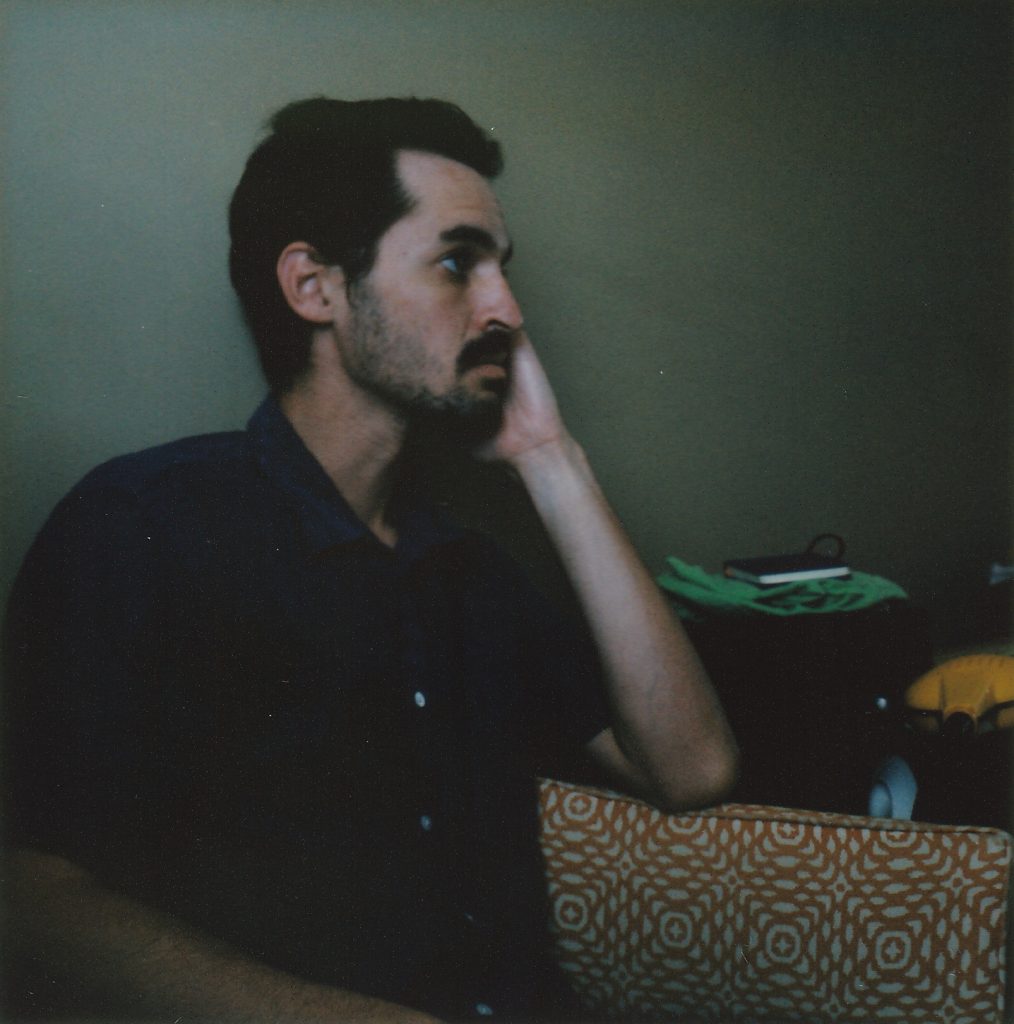
About the author: David Alpert is an artist and curator from Kansas City. His work is multi-disciplinary with a focus on archive, publication, autobiography, and photography. He is a core member of Stray Cat Film Center, a volunteer-run non-profit microcinema. He has a BA in Economics from Occidental College and an MFA in Sculpture with an Emphasis in Curatorial Practice from MICA. For more information, please visit his website, www.alpert.online.
